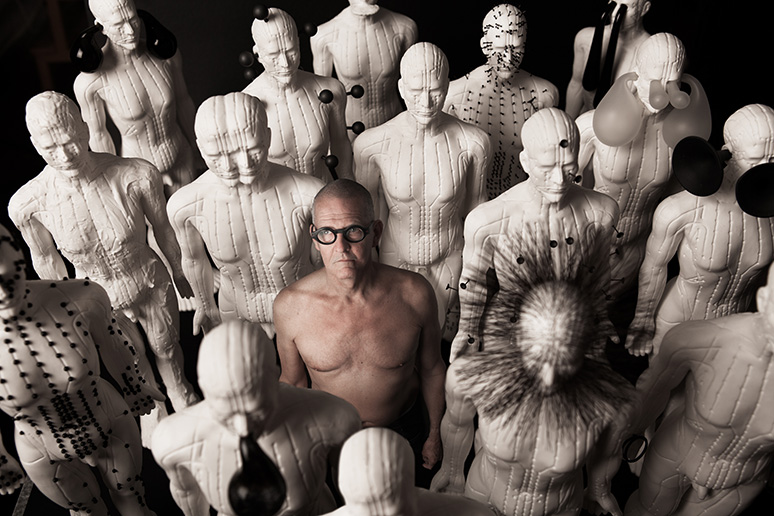CFile spotted Ruudt Peters work on the booth of Ormantum, a Hudson, New York gallery at Design Miami. The work is explored with depth and with sensitivity in this excerpt from the essay “Lost and Found” by Fredric Baas, Curator of the Stedelijk Museum ’s-Hertogenbosch:
Travellers to strange and distant realms, and anyone who has ever seen the film Lost in Translation (Sofia Coppola, 2003), knows the mixture of desperation, disorientation and melancholy that catches up with a tourist who stays any length of time in foreign lands. Jewellery maker Ruudt Peters had a similar experience during his stay in China in 2012. Apart from the overwhelming presence of billions of Chinese, it entailed being immersed in a country that appears to be losing itself in lightning-fast economic and social developments. At the cultural level the Chinese penchant for collectivism, which reaches back to the Confucian predilection for harmony, is the most obvious difference. It is no wonder that Ruudt Peters, who as a Westerner and an artist in fact has a double dose of individuality, often felt himself to be a castaway in an ocean of Chinese. At the same time his sensibility as an artist enabled him to transform the experiences which he encountered during his stay in China into a productive substratum for his creative process. Peters brought about this transformation in two ways: first by constructing a thematic bridge to the rest of his oeuvre, and second by making use of China’s status as the workshop of the world.
A good example of how Ruudt Peters translates a personal experience into an artwork is found in the group of 99 human figures entitled Cun Zai (being/ to be). This work arose from a visit to the terracotta army of Emperor Jing Di. In contrast to the terracotta army of Xi-an, this lesser-known army was realized at half life-size. In addition, Jing Di’s soldiers are no longer standing in ranks. After their clothing and moveable wooden arms rotted away, they tumbled over on one another.
This confusion of half-humans resonated so powerfully with Peters that he wanted to assemble his own army. Ultimately that became a company of 99 men. Following the ‘dissociative’ approach described above, he had moulds of meridian models from acupuncture combined and transformed by others. Subsequently he himself, in China and back in The Netherlands, made additions referring to specific experiences during his trip to China, transforming the uniform mass into a collection of individuals.
This sculptural group therefore best embodies the synthesis between East and West that Ruudt Peters has achieved with his manner of working. In drawing on his knowledge of Western alchemy to delve into Chinese alchemy, he has, in a quite spontaneous manner, been able to make substantive connections between his oeuvre as it has developed to this time, and becoming acquainted with another culture. As a result, these works are not Fremdkorper within his oeuvre.
More important, however, is the detached manner in which the work has been created. Peters, as an artist, and as an individual, has consciously kept his distance. In this way he has allowed something of the Taoist thought and the collectivism which is so definitive for Chinese culture to enter into his artistic process. And in this way Peters also refutes Rudyard Kipling’s famous lines, “East is East, and West is West, and never the twain shall meet.”
By letting go of the Western notion of authenticity in favour of a more collective and disengaged approach to the work, he has generated unexpected and ambiguous results. For example, both the weather-beaten faces of the ba xian and the Chinese mountain landscapes that are often depicted on paper scrolls can be discerned in the drawings on the steles.
Ruudt Peters did not journey to the Far East in quest of truth, as have so many others before (and after) him. Yet it would seem that he wants to share a piece of wisdom with us in these works.
Perhaps it can be phrased as follows: lost and found are two sides of the same coin.
Or did I read that in a fortune cookie somewhere?
Fredric Baas is the Curator of the Stedelijk Museum ’s-Hertogenbosch, the Netherlands.
Above image: Ruudt Peters digitally inserted into his army of 99 porcelain figures titled, Cun Zai. Courtesy of Ormantum of Hudson, New York.






Ruudt Peters, Cun Zai, 2013. 99 porcelain “Qi” figures that are embellished with silver, iron, glass, and horsehair. Each figure is approximately 41 × 15 × 5 cm. All images courtesy of Ormantum of Hudson, New York.
Read an interview with Peters at Noovo

Add your valued opinion to this post.